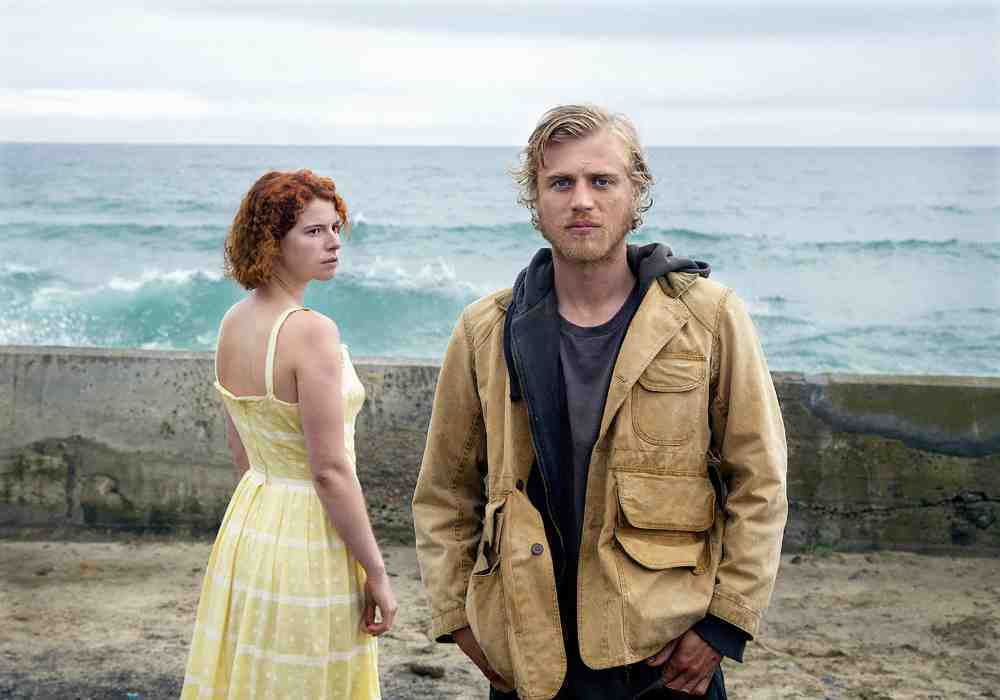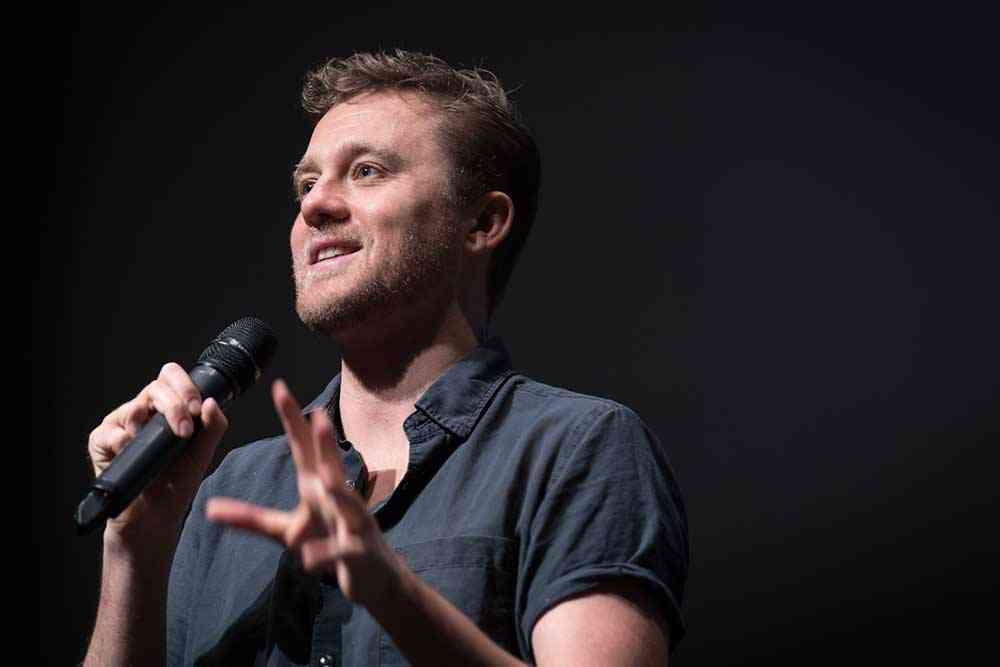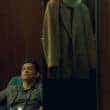Director Michael Pearce discusses directing actors and developing the eerie tone of his directorial debut Beast, a psychological thriller with formal ambition. Read the rest of our Sundance 2018 coverage here.

Between William Oldroyd’s Lady Macbeth and Michael Pearce’s Beast, stories about female monsters breaking free are launching some of Britain’s most exciting new filmmakers. Both films competed in the Toronto International Film Festival’s Platform program — designed to spotlight auteurist cinema — before screening in the Sundance Film Festival’s Spotlight program. Lady Macbeth put the very talented Florence Pugh on the map, and I expect similar returns for Beast star Jessie Buckley, who already has much TV and stage work behind her.
Set against the gorgeous landscapes of Jersey, Moll (Jessie Buckley) lives with an affluent family in a seemingly idyllic world. But behind closed doors, she feels trapped, forced to suppress her own desires by her controlling mother (Geraldine James). Then, Moll meets Pascal (Johnny Flynn), a mysterious stranger who rescues her from a date on the verge of turning rapey. In turn, she unwittingly helps him with an alibi. As their romance blossoms, she starts to find personal freedom, happiness — and her voice. But she knows little about him. Lurking in the background is the reminder that there’s a serial killer on the loose who is targeting teenage girls — and even Moll is a suspect.
Everyone in the film is playing a part. Moll pretends to be a sweet and doting daughter, and to a degree, an innocent flower for Pascal — who happens to enjoy rough, passionate, animalistic sex. Pascal, meanwhile, finds himself cast in the role of her rescuer, the handsome man who will solve her problems — a role he embraces as often as he chafes against it. Pearce expertly brings out the duality in all of these relationships, questioning who the characters are, who they think they are, and whether they even know the difference. When Moll and Pascal run up the Jersey shoreline, he juxtaposes bright colours of the romantic surroundings with an eerie score, reminding us there’s more here than meets the eye. Sometimes, he goes too far, and the film dips into overwrought territory.
But this world and these characters are mesmerizing, and the performances Pearce elicits from his actors are impressive. Throughout Beast, Buckley goes through an impressive physical transformation from someone closed off, small, and uncomfortable, to a looser, freer physicality — until she finally lets go of all socially accepted behavioural norms. Flynn, who cannot do Shakespeare but is occasionally OK in contemporary films, is perfectly cast here: the blankness that is often his weakness is now a strength. Moll is constantly projecting onto Pascal, and Flynn’s performance allows us to do so, too, with just a few glimpses at the cracks in his carefully constructed façade.
I talked to first-time feature filmmaker and screenwriter Michael Pearce about crafting the film’s visual and aural aesthetic and how he approaches working with actors to get these remarkable performances.
Seventh Row (7R): Beast is quite beautiful, but it’s also eerie. How did you think about creating the tone and aesthetic?
Michael Pearce: We made the decision not to try and draw tension from the landscape, which, conventionally, is what you’d do in a horror film. There have been many British films that are gloomy, dark, and gothic. That didn’t fit with my childhood growing up in Jersey. We were trying to juxtapose the scenery and the landscape against the horror of the crimes.
Since we weren’t drawing tension from that, we were trying to do it through things like music. It’s quite an intense score. It comes from within Moll’s emotional perspective. She might be at some kind of family gathering, at a barbecue. It seems quite nice, on the outside, but we’re trying to connect with the pain Moll feels under her skin.
We were trying to use certain camera techniques, like slow, deliberate tracks or zooms, just to get that sense of eeriness. It wasn’t supposed to be a horror film with jumps, but a general, growing sense of unease.
[clickToTweet tweet=”‘There have been many British films that are gloomy, dark, and gothic. That didn’t fit with my childhood growing up in Jersey.'” quote=”‘There have been many British films that are gloomy, dark, and gothic. That didn’t fit with my childhood growing up in Jersey.'”]
7R: How did you think about when you were going to move the camera and when you wanted it to be still? It seems like every time Moll runs after Pascal, it becomes handheld. But inside her house, and during much of their courtship, it’s more still and formal.
Micheal Pearce: We had two main languages for how we would use the camera. When she’s trapped in her home environment, or if she’s being interrogated by the police — if she’s in a scenario where she’s trapped — we kept the camera more steady. It’s on sticks. Occasionally, we would have very slow tracks or very slow zooms. The editing pace would be more slow and deliberate.
When Pascal comes into her life, it starts to become more fluid. Then, we’re exclusively using handheld within their relationship. The editing is a bit more impressionistic; it’s not necessarily guided by continuity. You can be a bit more lyrical between the cutting.
For example, when they move into the house together, we cut from her at the golf club smashing up the course, to the waves, to the bedroom, and then they’re in the forest and the garden. You’re going back and forth. You start to conflate what might be a few days into a couple of minutes. Up until that point, it’s followed a much more strict continuity. It seemed like that was the right language to utilize for those moments where she’s falling in love. But when she’s with the family, there was that sense of oppression.
These were the broad things about how imprisoned she feels versus how free she feels. Sometimes, we broke those rules if it felt right for the scene. I don’t want to be too schematic about it.
Near the end of the film, when she starts to feel more imprisoned within that relationship, it starts to return toward that more deliberate pace — more formal compositions.

7R: It seems like all the characters in Beast are playing roles. They’re either lying to themselves or to each other. How do you think about what you want to reveal or conceal? And how does that play into how you direct the actors and the scenes?
Michael Pearce: A big aspect of the film was that duality. It’s a safe island, but there are these horrific crimes going on. There’s this family that seems quite wholesome, even aspirational, from the outside. Inside, there’s something quite dysfunctional about it. Each of the characters is telling some kind of lie, including the main character, sometimes to themselves.
There were different strategies for trying to elicit that duality. When you’re trying to direct that, you don’t want to overcomplicate it. You’re still trying to find a playable throughline for the actors. I’d step away, and I’d think to myself, “Is there another inflection we could give this that would reveal that layer?” Maybe the camera can do that, or the writing can do that. The same is true of music. You put on a different piece of music, and suddenly, a scene that seemed quite benign can seem sinister.
Sometimes, good acting is just giving someone a simple objective. For example, the overriding objective for the detective, when she’s interviewing Moll, is “You have to get the truth out of this girl who is keeping it caged.” So what are the different strategies to do that? You can make friends with her and cajole it out of her. It was just trying to give the actress a certain angle. “You can’t make friends with her anymore. Try to threaten her with a worse alternative.”
It can be very easy for directors to overcomplicate their direction, and I’m very guilty of that, as well. So I always try, as much as possible, to give the actors some kind of active verb or goal or some “as if”. Most of the time, I think that’s helpful for actors. Sometimes, it’s hard to find that and articulate it, because it can be quite a nuanced thing.
[clickToTweet tweet=”‘I’d think to myself, ‘Is there another inflection we could give this that would reveal that layer?” Maybe the camera can do that, or the writing can do that.'” quote=”‘I’d think to myself, ‘Is there another inflection we could give this that would reveal that layer?” Maybe the camera can do that, or the writing can do that.'”]
7R: How did you prepare with the actors for Beast?
Michael Pearce: We only had a few days. I had it with Jessie [Buckley] and Johnny [Flynn], who play Moll and Pascal, and a bit with Geraldine [James], who plays Hilary, the mother, and a bit with Trystan [Gravelle], who plays the police officer Clifford. Even then, it was as much about just getting to know each other a bit and creat[ing] some intimacy with the actors, as opposed to deeply workshopping a scene.
But I do exchange emails with them and phone calls. I don’t want to be having really deep conversations about the characters on set. That should be done before you’re there. I try to cover a lot of that ground and make sure we’re approximately singing from the same hymn sheet.
When we’re on set, we’re talking about different ways of execution. It should be a creative space where we’re discovering new things — not, in the limited time we have, debating “Would the character do this or not?”.
Before going on set each day, I’d go over my notes. Almost with every line of dialogue, I’d try to think of a way to help the actor. Most of the time, they don’t need it. But if they ask me, I’ve run through that conversation in my head. Again, I almost don’t look at those notes. I just try to respond to them in a very immediate way. By virtue of giving myself that homework, as an exercise, that preparation sets you free to be more instinctual. It’s kind of a strange paradox: the more prepared you are, the more you can feel loose and responsive.
[clickToTweet tweet=”‘I don’t want to be having really deep conversations about the characters on set. That should be done before you’re there.'” quote=”‘I don’t want to be having really deep conversations about the characters on set. That should be done before you’re there.'”]
7R: Can you tell me about the sound design for Beast?
Michael Pearce: Me and Gunnar Oskarsson, the sound designer, we’ve done quite a few shorts together. We really like [the sound to] feel real enough that the audience isn’t thinking about it.
The subjectivity of sound and how you can use it in an expressive way is really fascinating. You can affect the audience subconsciously. You’re so used to reading an image, but sound can sneak in the back door and infect the way you interpret a film. It’s a really powerful tool. It’s one of my favourite aspects to play with and modulate.
[clickToTweet tweet=”‘You’re so used to reading an image, but sound can sneak in the back door and infect the way you interpret a film.'” quote=”‘You’re so used to reading an image, but sound can sneak in the back door and infect the way you interpret a film.'”]
The film is told exclusively from Moll’s emotional perspective, so we didn’t want to pick up just documentary sound. This wasn’t a film objectively studying her. It was a subjective, experiential take on her world. It was trying to find: what are the details in the scene? What could we emphasize, to heighten that feeling that she’s experiencing? That could be turning up the sound of the crickets. If it’s a gentle scene, we went through so many sounds of birds tweeting. It was figuring out which sound would heighten that feeling, and trying to capitalize on that.

